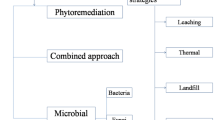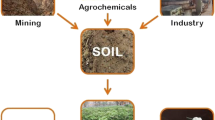Abstract
Serpentine soils, which contain relatively high concentrations of nickel and some other metals, are the preferred substrate for some plants, especially those that accumulate Ni in their tissues. In temperate regions more Ni-hyperaccumulator plants are found in Alyssum than in any other genus. In this study, serpentine soils of two areas (Marivan and Dizaj) in the west/northwest of Iran and also perennial Alyssum plants growing on these soils were analyzed for Ni and some other metals. The highest concentrations of total metals in the soils of these areas for Ni, Cr, Co and Mn were 1,350, 265, 94 and 1,150 μg g−1, respectively, while concentrations of Fe, Mg and Ca reached 3.55%, 16.8% and 0.585% respectively. The concentration of exchangeable Ni in these soils is up to 4.5 μg g−1. In this study two Alyssum species, A. inflatum and A. longistylum, have been collected from Marivan and Dizaj, respectively. Analysis of leaf dry matter shows that they can contain up to 3,700 and 8,100 μg Ni g−1, respectively. This is the first time that such high Ni concentrations have been found in these species. The concentrations of other metals determined in these species were in the normal range for serpentine plants, except for Ca, which was higher, up to 5.3% and 3.5%, respectively

Similar content being viewed by others
References
Adıgüzel N, Reeves RD (2002) A new nickel-accumulating species of Alyssum (Cruciferae) from Western Turkey. Edinb J Bot 59:215–219
Baker AJM (1981) Accumulators and excluders: strategies in the response of plants to trace metals. J Plant Nutr 3:643–654
Baker AJM, Brooks RR (1989) Terrestrial higher plants which hyperaccumulate metallic elements—a review of their distribution, ecology and phytochemistry. Biorecovery 1:81–126
Boyd RS, Martens N (1998) Nickel hyperaccumulation by Thlaspi montanum var. montanum (Brassicaceae): A constitutive trait. Amer J Bot 85:259–265
Brooks RR, Lee J, Reeves RD, Jaffré T (1977) Detection of nickeliferous rocks by analysis of herbarium specimens of indicator plants. J Geochem Explor 7:49–57
Brooks RR, Radford CC (1978) Nickel accumulation by European species of the genus Alyssum. Proc Roy Soc Lond B 200:217–224
Brooks RR, Morrison RS, Reeves RD, Dudley TR, Akman Y (1979) Hyperaccumulation of nickel by Alyssum Linnaeus (Cruciferae). Proc Roy Soc Lond B 203:387–403
Brooks RR (1987) Serpentine and its vegetation. Dioscorides Press, Portland, Oregon, pp 454
Brooks RR (1998) Plants that hyperaccumulate heavy metals. CAB International, Wallingford, pp 380
Dudley TR (1965) Alyssum Linnaeus. In: Davis PH (ed) Flora of Turkey and the East Aegean Islands, vol 1 Edinburgh University Press, UK, pp 398–399
Freitas H, Prasad MNV, Pratas J (2004) Analysis of serpentinophytes from north-east of Portugal for trace metal accumulation - relevance to the management of mine environment. Chemosphere 54:1625–1642
Ghaderian SM, Baker AJM (2007) Geobotanical and biogeochemical reconnaissance of the ultramafics of Central Iran. J Geochem Explor 92:34–42
Ghaderian SM, Mohtadi A, Rahiminejad MR, Baker AJM (2007) Nickel and other metal uptake and accumulation by species of Alyssum (Brassicaceae) from the ultramafics of Iran. Environ Pollut 145:293–298
Hedge I, Rechinger KH (1968) Cruciferae. In: Rechinger KH (ed) Flora Iranica, Akademische Druck-u., Verlagsanstalt, Graz, Austria, pp 1–372
Li Y-M, Chaney RL, Brewer EP, Angle JS, Nelkin JP (2003) Phytoextraction of nickel and cobalt by hyperaccumulator Alyssum species grown on nickel-contaminated soils. Environ Sci Tech 37:1463–1468
Lombini A, Dinelli E, Ferrari C, Simoni A (1998) Plant-soil relationships in the serpentinite screes of Mt Prinzera (Northern Apennines, Italy). J Geochem Explor 64:19–33
Proctor J (1999) Toxins, nutrient shortages and droughts: the serpentine challenge. Trends Ecol Evol 14:334–335
Reeves RD (1992) The hyperaccumulation of nickel by serpentine plants. In: Baker AJM, Proctor J, Reeves RD (eds) The vegetation of ultramafic (serpentine) soils, Intercept Ltd, Andover, pp 253–277
Reeves RD (2005) Hyperaccumulation of trace elements by plants. In: Morel J-L, Echevarria G, Goncharova N (eds) Phytoremediation of metal-contaminated soils. (Proceedings of the NATO Advanced Study Institute, Třešť Castle, Czech Republic, 18–30 August 2002), NATO science series: IV: earth and environmental sciences, Vol 68. Springer-Verlag, Berlin, pp 25–52
Reeves RD, Adıgüzel N (2004) Rare plants and nickel accumulators from Turkish serpentine soils, with special reference to Centaurea species. Turk J Bot 28:147–153
Reeves RD, Baker AJM (2000) Metal accumulating plants. In: Raskin I, Ensley BD (eds) Phytoremediation of toxic metals: using plants to clean up the environment, John Wiley & Sons Inc., NY, USA pp 193–229
Reeves RD, Baker AJM, Borhidi A, Berazaín R (1996) Nickel-accumulating plants from the ancient serpentine soils of Cuba. New Phytol 133:217–224
Reeves RD, Baker AJM, Borhidi A, Berazaín R (1999) Nickel hyperaccumulation in the serpentine flora of Cuba. Ann Bot 83:29–38
Reeves RD, Baker AJM, Kelepertsis A (1997) The distribution and biogeochemistry of some serpentine plants of Greece. In: Jaffré T, Reeves RD, Becquer T (eds) Écologie des milieux sur roches ultramafiques et sur sols métallifères, ORSTOM, Nouméa, pp 205–207 Documents Scientifiques et Techniques No. III/2
Reeves RD, Brooks RR, Dudley TR (1983) Uptake of nickel by species of Alyssum, Bornmuellera, and other genera of Old World Tribus Alysseae. Taxon 32:184–192
Reeves RD, Kruckeberg A, Adıgüzel N, Krämer U (2001) Studies on the flora of serpentine and other metalliferous areas of western Turkey. S Afr J Sci 97:513–517
Shallari S, Schwartz C, Hasko A, Morel JL (1998) Heavy metals in soils and plants of serpentine and industrial sites of Albania. Sci Total Environ 209:133–142
Stevanović V, Tan K, Iatrou G (2003) Distribution of the endemic Balkan flora on serpentine I—obligate serpentine endemics. Plant Syst Evol 242:149–170
Wenzel WW, Jockwer F (1999) Accumulation of heavy metals in plants grown on mineralized soils of the Austrian Alps. Environ Pollut 104:145–155
Wenzel WW, Bunkowski M, Puschenreiter M, Horak O (2003) Rhizosphere characteristics of indigenously growing nickel hyperaccumulator and excluder plants on serpentine soil. Environ Pollut 123:131–138
Acknowledgement
SMG would like to thank the University of Isfahan for providing research facilities for this study.
Author information
Authors and Affiliations
Corresponding author
Rights and permissions
About this article
Cite this article
Ghaderian, S.M., Mohtadi, A., Rahiminejad, R. et al. Hyperaccumulation of nickel by two Alyssum species from the serpentine soils of Iran. Plant Soil 293, 91–97 (2007). https://doi.org/10.1007/s11104-007-9221-9
Received:
Accepted:
Published:
Issue Date:
DOI: https://doi.org/10.1007/s11104-007-9221-9




